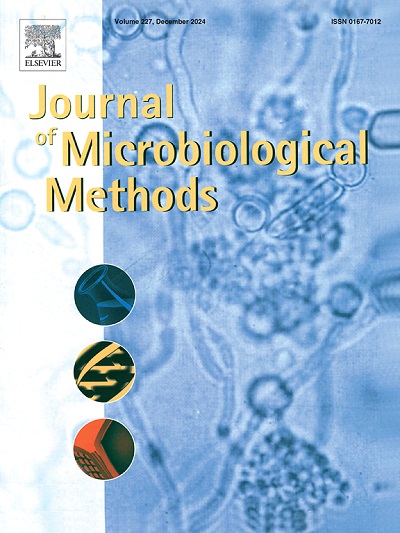Bibliometric review and perspectives on the biological activity of polyoxometalates against resistant bacterial strains
IF 1.7
4区 生物学
Q4 BIOCHEMICAL RESEARCH METHODS
引用次数: 0
Abstract
Research into alternative compounds for the treatment of bacterial infections has intensified in recent years due to the emergence of resistant bacterial strains and the obsolescence of traditional antibiotics. Polyoxometalates (POMs) are metal‑oxygen clusters of high-valent early transition metals that show promising biological activity against multidrug-resistant bacteria, with molybdenum-, tungsten-, and vanadium-containing POMs standing out. While the synthesis and physicochemical characterization of POMs has been studied and gradually understood in recent decades, the scientific community lacks more detailed information about their activity and biological action mechanism, demanding more scientific efforts for this purpose. This bibliometric review seeks to reduce part of this asymmetry by addressing the latest evidence on the antibacterial activity of POMs against different strains. To this end, scientific articles were searched in the SCOPUS and Web of Science databases between 1996 and 2023, using the descriptors “bacteria”, “polyoxometalates”, and “antibiotic activity”, resulting in over 1200 direct and indirect correlations. By focusing the research on case studies, around 60 scientific reports were selected and used in this review. Although the antibacterial activity of POMs is not recent, there has been an increase in speculation about this characteristic over the last decade, especially identified in Escherichia coli and Staphylococcus aureus strains. The different strategies studied to improve dose-response results, as well as the challenges and perspectives in this issue are also within the scope of this review, supporting further research in this area.
多金属氧酸盐抗耐药菌株生物活性的文献计量学综述及展望。
近年来,由于耐药菌株的出现和传统抗生素的过时,对治疗细菌感染的替代化合物的研究已经加强。多金属氧酸盐(POMs)是由高价早期过渡金属组成的金属氧簇,对耐多药细菌具有良好的生物活性,其中含钼、钨和钒的POMs尤为突出。近几十年来,人们对POMs的合成和理化性质进行了研究并逐渐了解,但科学界对其活性和生物作用机制缺乏更详细的了解,这需要更多的科学研究。本文献计量学综述旨在减少这种不对称的一部分,通过解决对不同菌株的聚甲醛抗菌活性的最新证据。为此,我们在SCOPUS和Web of Science数据库中检索了1996年至2023年间的科学文章,使用了“细菌”、“多金属氧酸盐”和“抗生素活性”等描述符,得出了1200多条直接和间接的相关性。通过将研究重点放在案例研究上,本综述选择并使用了大约60份科学报告。虽然聚甲醛的抗菌活性不是最近才发现的,但在过去十年中,人们对这种特性的猜测有所增加,特别是在大肠杆菌和金黄色葡萄球菌菌株中发现了这种特性。为改善剂量-反应结果而研究的不同策略,以及该问题的挑战和前景也在本综述的范围内,支持该领域的进一步研究。
本文章由计算机程序翻译,如有差异,请以英文原文为准。
求助全文
约1分钟内获得全文
求助全文
来源期刊

Journal of microbiological methods
生物-生化研究方法
CiteScore
4.30
自引率
4.50%
发文量
151
审稿时长
29 days
期刊介绍:
The Journal of Microbiological Methods publishes scholarly and original articles, notes and review articles. These articles must include novel and/or state-of-the-art methods, or significant improvements to existing methods. Novel and innovative applications of current methods that are validated and useful will also be published. JMM strives for scholarship, innovation and excellence. This demands scientific rigour, the best available methods and technologies, correctly replicated experiments/tests, the inclusion of proper controls, calibrations, and the correct statistical analysis. The presentation of the data must support the interpretation of the method/approach.
All aspects of microbiology are covered, except virology. These include agricultural microbiology, applied and environmental microbiology, bioassays, bioinformatics, biotechnology, biochemical microbiology, clinical microbiology, diagnostics, food monitoring and quality control microbiology, microbial genetics and genomics, geomicrobiology, microbiome methods regardless of habitat, high through-put sequencing methods and analysis, microbial pathogenesis and host responses, metabolomics, metagenomics, metaproteomics, microbial ecology and diversity, microbial physiology, microbial ultra-structure, microscopic and imaging methods, molecular microbiology, mycology, novel mathematical microbiology and modelling, parasitology, plant-microbe interactions, protein markers/profiles, proteomics, pyrosequencing, public health microbiology, radioisotopes applied to microbiology, robotics applied to microbiological methods,rumen microbiology, microbiological methods for space missions and extreme environments, sampling methods and samplers, soil and sediment microbiology, transcriptomics, veterinary microbiology, sero-diagnostics and typing/identification.
 求助内容:
求助内容: 应助结果提醒方式:
应助结果提醒方式:


